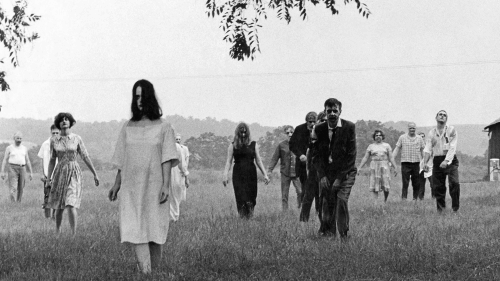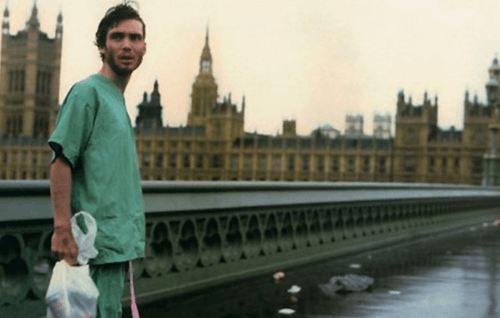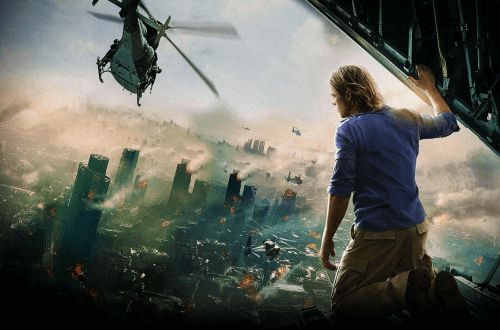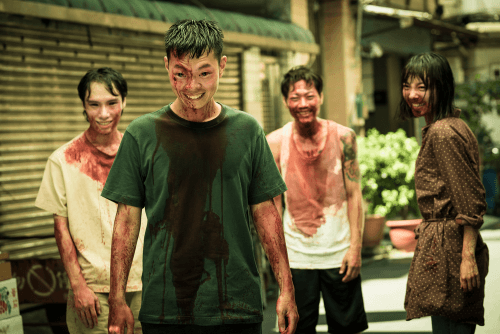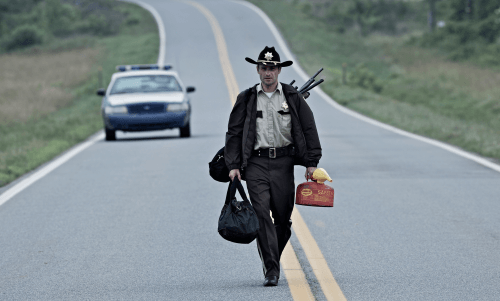
THE DEAD TIMES
DEAD ARE COMING...
The Top 6 Landmark Moments in Zombie Media
Zombies and Zombiism have been in our culture for years - even early man knew of the potential for the dead to reanimate (bodies being buried face-down, sometimes with stones in their mouths). That said Zombies as we know (and love) them today came around a while ago now (just over half a century) so I figured it would be a good time to recap some of the moments that made Zombies what they are today; the true landmark moments that shaped the way we think about the living dead. Of course, to note all such 'turning points' and 'memorable occasions' throughout the history of even just "modern" Zombies would be a futile task as there are simply too many. Who can forget the first time you encounter a Zombie in Resident Evil - the slow turn of the head, those cloudy eyes and bloodied teeth - or the hilarity provided by Shaun of the Dead - a Zombie movie that people often site as their favourite even to this day. I have limited this article to just six; six pinnacles of Zombie history that, without them, Zombiism in culture would be very, very different.
1. Night of the Living Dead
If there is one key landmark in Zombiism it would be the 1968 film by George A. Romero - it is, essentially, the birth of Zombiism in culture. Ok, ok, that is not completely true, Zombie movies had been around before Romero came on the scene - White Zombie and The Plague of the Zombies to name just two - but these were mired in mythology and superstition, of Voodoo religion and Bokors. Zombies were slaves to the living; recently dead, or seemingly dead, people brought back to life, working in fields or down mines at the behest of the living. Usually docile, these Zombies were only violent if they were told to be, they did not seek out or hunt the living, seeking to feed on their warm flesh. These first Zombies showed very little in common with the relentlessly hungry ghouls of almost zero-intelligence that we consider a "Zombie" today.
What Romero did was changed the whole idea of a Zombie into something monstrous, something biological, a plague that could turn you, me, anyone into slow-moving, braindead cannibals; they had one goal, to devour the flesh of the living and would stop at nothing to achieve that goal, no remorse, no morality, even pain or obvious danger would not deter them from their quest. They presented a largescale threat, not with superpowers or radical immunities like other staple horror-movie monsters like Werewolves or Vampires, but through there almost inconceivable numbers. They beat uselessly at barricaded doors, at closed windows with blank stares, making their seemingly evil intent, all the more sinister through lack of acknowledgement, any sign that they knew, or even cared, what they were doing. It's true, Romero did not actually intend to create these creatures of the night as Zombies and would only later, with his sublime works of Dawn of the Dead and Day of the Dead, solidify the true nature of modern Zombies. However, Night of the Living Dead was the stepping off point, the bridge between the world of the living and the land of the dead (pun fully intended). Had it not been for this single incredibly low-budget horror movie (at a meagre $100,000) shot in a defunct black & white from a first-time movie director, Zombiism would probably look very different today, if even exist at all!
In this first ever "true" Zombie movie, a young brother and sister, having witnessed the reanimated dead first-hand, the dead having managed to kill the brother in a ferocious attack, take refuge in a seemingly empty farmhouse. Soon another character, Ben, arrives at the house, run off the road by marauding ghouls. While the relentless undead try to get in the locked farmhouse, our two heroes barricade the doors and windows with whatever they can find (well, the man does, the traumatised woman just sits there, frozen in fear). Eventually, the two realise the farmhouse is not empty after all - a small party of survivors have been hiding out in the basement. And that's it basically; the film is just a frantic survival against the living dead, including the often fatal attempts at survivor groups with different ideas trying to cooperate. When the morning dawns and the nightmare is over, the local militia tasked with cleaning up the remaining walking corpses, shoot and kill Ben after mistaking him for a Zombie, demonstrating the wonderful hopelessness of a Zombie outbreak - if the reanimated dead don't get you, the untrained, gun-ho wannabe heroes are just as likely to.
2. 28 Days Later
In 2002, the world of Zombiism - which had fallen into ill-repute in the late 80s and 90s - changed forever, literally charging headfirst, screaming in ravenous bloodlust, into the limelight. Danny Boyle's 28 Days Later saw an injured man wake in a hospital bed to an evacuated London, left behind in the chaos, without any knowledge of what had befallen the happy, life-filled world he had left behind. A rampant virus known as RAGE had been unknowingly unleashed by animal rights activists and had quickly spread throughout the entire UK. Once infected, a living person would, within minutes, effectively become a Zombie; all emotion would be gone, all sense of humanity, intellect, everything other than the need to infect others and further the spread of the virus was gone. Their eyes would be bloodshot, they would run around frantically in search of prey, they would sniff the air for the scent of the uninfected, barfing infected blood into the face and mouth of any unfortunate soul they managed to pin to the floor, maximising the chance of that bad blood, entering the prey's bloodstream, ensuring infection. Nowhere was safe from these sprinting terrors unless you remained absolutely quiet and hidden; Zombies had changed from the slow-moving lurchers, only deadly in large numbers, to fast-moving, agile nightmare-fuel, that, even individually, could rip you limb from limb in seconds.
It's important to note the distinction here as these were not "Zombies" according to the rules laid down by George A. Romero. These where not dead people who had been reanimated, resurrected by some unknown power but living humans infected by a virus and becoming Zombies; the term "infected" or "living Zombie" was spawned to differentiate them from the rest. However, since that day in 2002, the Zombie landscape changed forever. This "living Zombie", this "infected", became the defacto "Zombie" - virtually every Zombie film, TV programme, comic book, whatever, made after this date had to feature these ultra-fast, ultra-deadly, 'in-your-face' Zombies for maximum "jump-scare" horror; Zombieland, the remakes of Dawn of the Dead and Day of the Dead, the long list of Resident Evil movies, the video game Resident Evil 5, DayZ, the book Patient Zero, are just a few Zombie products that involved running Zombies. There were a few exceptions to the trend; World of the Dead: The Zombie Diaries 2, Zombie Undead, Land of the Dead and Survival of the Dead, the final two both being directed by George Romero, stubbornly refusing to abandon the old ways. Whether Zombies can run and even whether 28 Days Later can actually be considered a Zombie movie at all is a source of huge debate among anyone with even the slightest interest in Zombies (even director Danny Boyle says it is not a Zombie film) but, whatever the answer, it really did not matter anymore, Hollywood had found the winning formula for the dying Zombie-genre and stuck with it.
It had also been established that a 'Zombie virus', like the one seen in 28 Days Later, was the "go to" cause of any Zombie plague. In previous movies and games, the cause of lumbering dead monstrosities to, quite simply, not stay dead was left ambiguous, particularly in the landmark Romero movies where it is hinted, on multiple occasions, but also discounted, that the Zombies are caused by radiation from a space probe sent to Venus, exploding in Earth's atmosphere.
Again, there were a small number of exceptions to the 'Zombie virus' mainstay; the game The Last of Us and the movie The Girl with All the Gifts stirred the pot by having a fungal outbreak instigate the turning of people into Zombies, but largely, any other cause than a biological virus was forgotten.
3. The Zombie Survival Guide
While the previous two landmarks were both very influential movies, this pivotal moment came from the written word (and is a personal turning point for me). Before the introduction of this epic tome, I liked Zombies, yes, but did I actually believe they were, or could be, real? Heck, I did not even entertain the question at that point. This was about to change. My whole life was about to change. I was about to take a far different, far darker and far bloodier path through life and all due to the fictional work of one man, author of fabled book The Zombie Survival Guide; Max Brooks.
I first came across The Zombie Survival Guide by accident - getting a cut-down "extract" version free with a copy of PC Zone magazine. After quickly hoovering up that and, later, the full volume, I was hooked, Zombies were real - my path towards The Dead Times and, indeed, this very article, was now unavoidable. It's difficult to explain exactly why I came to this conclusion but The Zombie Survival Guide was just so detailed, so 'everyday', written in a style that presented real-world problems, added Zombies to them and posed solutions without ever making fun of its fictional nature or the concept of dead people reanimating and attacking the living. The book just accepted that Zombies existed and told you how to survive - pure and simple. It also all 'made sense'; it never posed solutions using hypothetical equipment or went outside the box; every puzzle solved just 'seemed' right for what an average person would need to do in such a situation, just as if it had been survival against aggressive bears, survival in a hazardous environment or survival 'rules' for any other natural scenario.
The believability was also helped by the "Recorded Attacks" appendix. While all (probably) being works of the imagination, because of the rest of the book, they 'felt' real, felt plausible, like they could have happened, giving enough information to get the overall picture but painting that picture in such a way to make it appear that the exact details had gotten lost over time.
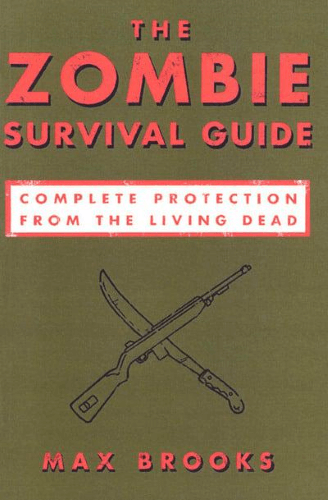
The book that convinced me that Zombies were real... and told me how to survive them.
However it was achieved, the point was clear and the Zombie mythology had changed again; Zombies were real and, if you followed some golden survival rules, you could survive them. This concept of 'rules' would go on to influence thousands of Zombie games - almost every open-world Zombie survival sandbox is grounded by players making and testing out their own Zombie survival plans - and, to a lesser extent, movies - more or less the entire concept of the Zombieland franchise is built around the idea of survivors having lists of rules they adopt to stay alive.
4. World War Z
Like it or hate it (and many true Zombie fans did indeed hate it), the movie version of World War Z is another landmark moment in the Zombie journey - this one however, may not be in the way you'd expect. First of all, to get it out the way, the book version of World War Z - another historic title in its own right and written by the same author as The Zombie Survival Guide no less - is far different to the movie version, to the point where they are best considered as two separate entities and, while the book found much more high praise than the film, I would only dub the extremely high-budget movie as a landmark in Zombie culture.
In World War Z we follow retired UN (United Nations) operative Gerry Lane who travels the globe, seeking a solution to the worldwide Zombie pandemic and attempting to trace its origins. It features extremely aggressive Zombies that can run at phenomenal pace and are extremely agile, normal traits of the "living Zombie". However, from their often-emaciated appearance and a complete disregard for their own safety, the film showing the Zombies running directly into live fire from machine guns or dropping from great heights, shattering bones, these were true undead; the reanimated corpses of those who had died. This mixing the definition of "Traditional" and "Living" Zombies was seen before in the 2004 remake of Dawn of the Dead and, would go onto be seen in the infamous Korean Zombie movie, Train to Busan.
The film also introduced the idea of truly massive Zombie swarms becoming almost like water; tidal waves of Zombies crashing into large objects to force them over with the weight of thousands of surging bodies and the horror of hundreds of rotting corpses literally bounding over each other in an insane moving stream of teeth and flesh. The Zombies could form structures with their bodies - possibly showing some rudimentary group intelligence but more likely a result of desperate bodies all clambering on top of each other to reach the same goal; the irresistible, yet out-of-reach, living humans. This would be seen again in the game version of World War Z and in Days Gone.
This new type of Zombiism was undoubtedly cool and would help shape the future of the Zombie menace but, by far the biggest influence of World War Z was just how many people saw it. It starred Brad Pitt, a main-stream actor and a cut above the usual low-tier actors who usually star in Zombie movies. With all the marketing and hype, trailers, posters, cast interviews, big-budget action - people, and crucially not just Zombie fanatics, were excited. Through the end movie did not really live up to that extreme hype, it still became the highest grossing movie to star Brad Pitt and, for a few years anyway, the highest grossing Zombie film of all time, grossing over $540 million worldwide. World War Z made Zombies mass-market, they had broken out of their, admittedly fairly large, cult following and were now worldwide - the Zombie fanbase may not have grown significantly but the word was out, people who had no interest in Zombies now knew what Zombies were. In my opinion, the film many deemed lacklustre, simply does not get enough credit for how much it achieved.
It was this 'bigness', this high-profile status, extreme mass marketing, that is the double-edged sword of World War Z's landmark status. It obviously all came at a cost, a monumental one for the time - a hundred and ninety million dollars! This would go on to all but destroy the Zombie genre in cinema for years to come - arguably, we are still feeling the effects just now (don't even get me started on the planned, long-delayed and then ultimately cancelled sequel, World War Z 2). I'm not exactly sure on the details but the whopping dollar value put many potential movie producers off the idea of funding a Zombie movie - assuming that anything would need to go even bigger for better results and to meet the new levels of expectation fans would have (an assumption which, I deem entirely stupid). This is especially true for the modern cinematic era of today where IP (Intellectual Property) and sequels to established franchises are "big" deals - again, producers wrongly assuming that, once an original movie sets a budget, all subsequent movies in that franchise need to have a higher budget. In other words, it had become virtually impossible for new Zombie movies to get the funding they required and, hence, hardly any aspiring Zombie movies ever saw the light of day.
5. The Sadness
This is a low-budget Taiwanese movie written and directed by a Canadian filmmaker who, like George A. Romero, had never made a film before. It was released exclusively on the online streaming platform Shudder.
The story of The Sadness is basically a horrific spin on the global coronavirus pandemic of 2019 to 2022 (it is over now, right?). A new virus of mysterious origin has been discovered and is spreading across the population. However, unlike the real-world covid pathogen, this evil virus turns those infected into sadistic homicidal maniacs - they will stop at nothing to torture and kill uninfected humans, having no benefit or reason to do so. It is, as the title suggests, a very bleak movie with even the ending being miserable. That said, it is an exceptionally well-made movie with buckets of gore that I would recommend to anyone.
While these sadistic infected are definitely not what I would call "Zombies", I can see this as being the next 'stepping stone' on Zombie evolution. It’s the fact that these homicidal freaks are self-aware that makes be believe this - they know they are infected, they know they can withstand more pain than others, they know the actions they are doing are 'wrong' but they have no desire, or possibly cannot, stop. We have seen this 'self-aware' nature of Zombies before, all be it on a less-graphic level with George A. Romero's Day of the Dead (where the Zombie, Bub, clearly knew what he was doing) and Land of the Dead (where the Zombie, Big Daddy, actual uses his abilities to educate other Zombies).
6. The Walking Dead
The monumental importance of The Walking Dead franchise - spanning TV programmes, comics, novels and games - cannot be overstated and, as perhaps a controversial decision, I am going to focus on what, for many, was probably their introduction to the universe; the TV series.
The story has dramatically expanded over the eleven seasons but essentially the show follows Rick Grimes - a sheriff in Atlanta who was recovering from a gunshot wound and awoke to a full-blown Zombie apocalypse. Initially, Rick struggles to find his family and when he does, he faces a day-by-day struggle to keep his family alive. He also encounters other survivors who he bands together with for safety in numbers. When Rick and his family eventually die, the other survivors - now joined by even more survivors - start to rebuild civilization eventually stumbling across a far larger survivor group who have the same idea, though started the process much earlier and, as a result, have much more advanced technology.
Pre-2010, Zombies had never really survived on television - there had been some failed attempts to make the living dead mass-media, some one-off episodes shoved into existing shows, but nothing had gone down that well. In the early 2000s there was the idea to adapt the long-running comic book series The Walking Dead into a TV show. The concept of adapting this comic had been around for a while so people were more than a little dubious, including franchise creator Robert Kirkman. However, when the first season of the show released in 2010, with a poultry six-episodes, the stars aligned and The Walking Dead - a show featuring slightly sped-up old-school, traditional undead Zombies - became the single most watched show in TV history. Disappointingly, with subsequent seasons, the TV show declined in popularity and viewer-numbers though still manage to maintain a massive diehard fanbase. Zombies had wormed their rotten appendages into the world of mass-market TV and, while the phenomenal early success does appear to have blotted-out all Zombie shows not related to The Walking Dead universe, the rise of the living dead on TV shows no sign of falling. Several spin-off shows and game adaptions have been released or have been announced and there was even talk of movies at one point, though I think these have now been cancelled due to lack of updates.
A large part of the popularity of the show - even in its less popular phase - was down to talented actors including Norman Reedus, Melissa McBride, Steven Yeun and Jon Bernthal (to name but a few), believable stories (it did get a bit absurd in the later seasons), and the absolutely amazing Zombie effects work by Greg Nicotero and the visual effects studio he co-founded; KNB Efx Group.
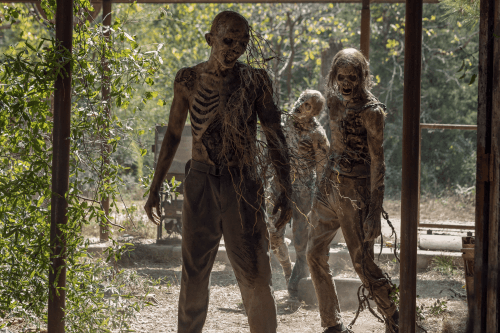
Some Zombies have been around so long they even have plants growing out of them.
DESCRIPTION:
In this truly fangtastic article, I go through a list of 6 of the greatest, most historic, landmark moments in Zombie history within the media; books, films, TV shows and more. These moments defined what a Zombie is, what Zombiism is and, taken together, presented the, often bumpy, evolution of the living dead.
CATEGORY:
Scientific
WRITTEN BY:
DATE UPLOADED:
02/10/2022

